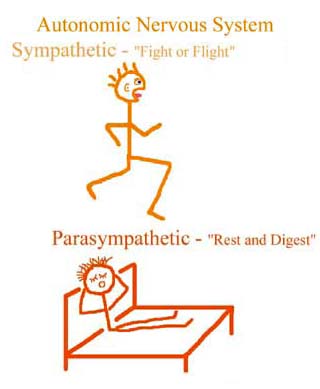 The autonomic nervous system regulates homeostasis via two opposing divisions: the sympathetic division and the parasympathetic division. Both the sympathetic and parasympathetic systems innervate most of the body's organs and act in opposition to one another to maintain normal physiology, including blood pressure, blood oxygen levels, and nutrient levels. The amount of work that a given organ must do to maintain homeostasis differs from one situation to the next. In addition, certain organs need to work to prepare the body for possible future situations. These functions are all regulated by the autonomic nervous system. The autonomic nervous system regulates homeostasis via two opposing divisions: the sympathetic division and the parasympathetic division. Both the sympathetic and parasympathetic systems innervate most of the body's organs and act in opposition to one another to maintain normal physiology, including blood pressure, blood oxygen levels, and nutrient levels. The amount of work that a given organ must do to maintain homeostasis differs from one situation to the next. In addition, certain organs need to work to prepare the body for possible future situations. These functions are all regulated by the autonomic nervous system.
The sympathetic division of the autonomic nervous system is the division that prepares the body for stressful situations. It is often referred to as the "fight or flight" system. The effects of this system are numerous, but generally include increasing heart rate, constricting blood vessels to the skin and viscera (thereby increasing blood flow to muscles), increasing pupil size and decreasing salivation. These responses all promote survival in a dangerous situation.
The parasympathetic division of the autonomic nervous system prepares the body for restful situations and is often called the "rest and digest" system. Effects of the parasympathetic nervous system include slowing heart rate, increasing gastric motility, and increasing salivation. These responses help the body to recover as well as prepare for stressful situations by storing nutrients.
The parasympathetic and sympathetic systems do not work entirely separately, but rather work at the same time, often in opposition to one another. For example, while relaxing on a hot day after a meal, your parasympathetic nervous system may predominate as your food digests, but your sympathetic nervous system will be actively innervating sweat glands. On the other hand, if the building you were in suddenly caught fire, your sympathetic nervous system would predominate. The sympathetic and parasympathetic nervous systems may be thought of like a water faucet with hot and cold water balancing one another to make the perfect water temperature for anything from a cold glass of water to drink to a relaxing hot bath.
|






 The autonomic nervous system regulates homeostasis via two opposing divisions: the sympathetic division and the parasympathetic division. Both the sympathetic and parasympathetic systems innervate most of the body's organs and act in opposition to one another to maintain normal physiology, including blood pressure, blood oxygen levels, and nutrient levels. The amount of work that a given organ must do to maintain homeostasis differs from one situation to the next. In addition, certain organs need to work to prepare the body for possible future situations. These functions are all regulated by the autonomic nervous system.
The autonomic nervous system regulates homeostasis via two opposing divisions: the sympathetic division and the parasympathetic division. Both the sympathetic and parasympathetic systems innervate most of the body's organs and act in opposition to one another to maintain normal physiology, including blood pressure, blood oxygen levels, and nutrient levels. The amount of work that a given organ must do to maintain homeostasis differs from one situation to the next. In addition, certain organs need to work to prepare the body for possible future situations. These functions are all regulated by the autonomic nervous system.